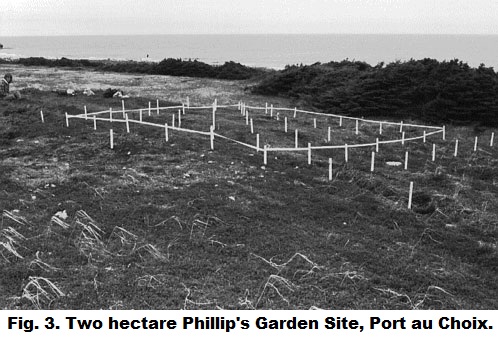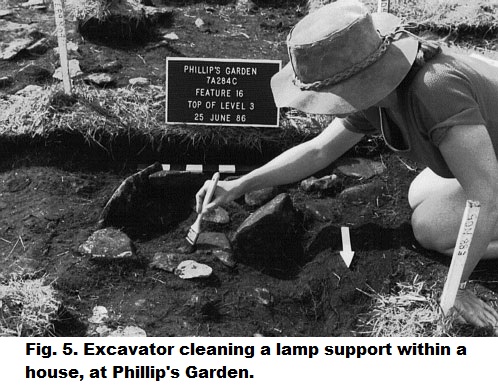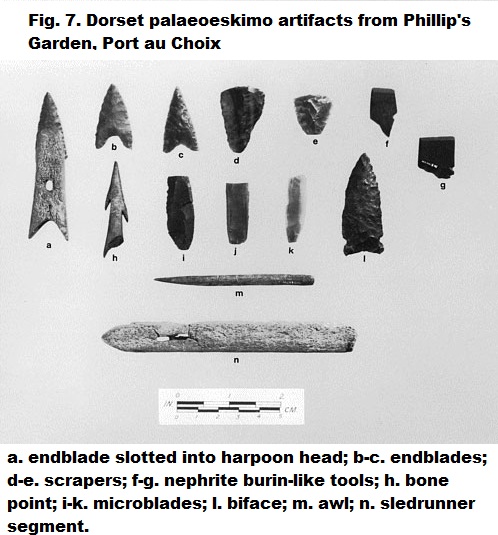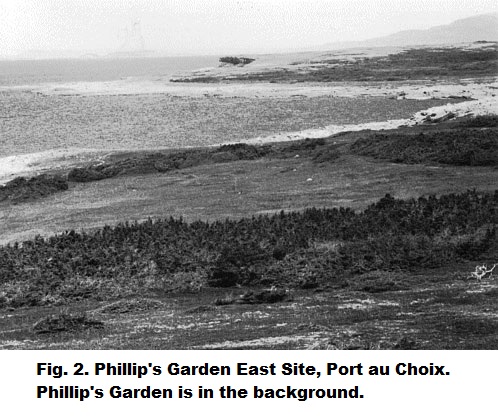Palaeoeskimo in Newfoundland & Labrador
Palaeoeskimo in Newfoundland & Labrador
By M.A.P. Renouf
Fall 1991
[Originally published in printed form]
 From approximately 4000 to 900 years ago, palaeoeskimo groups lived in the eastern Canadian arctic (Fig. 1). The term "palaeoeskimo" literally means "prehistoric Eskimo" and is used to distinguish these eastern arctic groups from modern Inuit, who are not their direct descendants. Remains of palaeoeskimo settlements are found from Greenland and Ellesmere Island in the High Arctic, south to Baffin Island, Labrador, the shores of Hudson Bay and, at their southernmost extreme, the Island of Newfoundland.
From approximately 4000 to 900 years ago, palaeoeskimo groups lived in the eastern Canadian arctic (Fig. 1). The term "palaeoeskimo" literally means "prehistoric Eskimo" and is used to distinguish these eastern arctic groups from modern Inuit, who are not their direct descendants. Remains of palaeoeskimo settlements are found from Greenland and Ellesmere Island in the High Arctic, south to Baffin Island, Labrador, the shores of Hudson Bay and, at their southernmost extreme, the Island of Newfoundland.
The origins of these palaeoeskimo are found in Alaska, where hunting and fishing groups occupied the coastal regions from 4500 years ago to the present day. At this time, when climatic conditions were warmer than they are today, some of these groups moved eastward, reaching the eastern Arctic in about 500 years. This 5500 km migration was probably accomplished as a series of events in which families moved several kilometres to the east as generations splintered off and moved into better hunting grounds where animals had not been exploited by humans before and were therefore easy prey. When these small groups reached the eastern arctic sometime around 4000 years ago, they spread throughout the region, where they adapted to particular areas and lived successfully for three millennia.
At around 1000 years ago, in another warm period, direct descendants of north Alaskan palaeoeskimo began another migration. Archaeologists call these people the Thule, after Thule in northwestern Greenland where artifacts belonging to this period were first found. The Thule had developed whale hunting technology in the Bering Sea and they brought this technologically and socially sophisticated technique with them as they crossed the Arctic in a much more rapid migration than that of their ancestors three millennia earlier. They reached Baffin Island and the High Arctic by 900 B.P. (before present) and extended as far east as northern Labrador by 500 years ago; they never reached the Island of Newfoundland. These whale hunters settled into their new homelands, eventually becoming sealers and caribou and musk-oxen hunters as they adapted their economy and technology to the local conditions. These are the direct ancestors of modern Inuit groups.
What of the already established residents, the palaeoeskimo? Archaeologists have not yet been able to answer this question as there are no archaeological sites that firmly indicate contact between Thule and palaeoeskimo groups. Perhaps some of these palaeoeskimo groups had already died out before the Thule arrived, perhaps some inter-married with the newcomers, or perhaps some groups were killed in hostile encounters. Or, possibly some of the palaeoeskimo residents continued to live in isolation and survived to historic times. It has been suggested that the Inuit of Southampton Island, the Sadlermiut, were such people. If so, they would have been one of the few surviving communities of a 4000 year old lineage. Unfortunately, this group was wiped out in the winter of 1902-1903 after contact with a European sailor who had influenza, against which the Sadlermiut had no resistance.
In Newfoundland and Labrador, the palaeoeskimo period is subdivided into early (4000-2100 B.P.) and late (2100-500 B.P.), based on differences in marine exploitation. The late palaeoeskimo were more intensely marine oriented than earlier palaeoeskimo groups.
The early palaeoeskimo groups had an economy which, although focused on marine resources, also had an important terrestrial component. Sites are located along the shores of bays and fjords, and on inner islands. They are small seasonal camps that were occupied by small residential groups which probably consisted of only one or a few families. Over the course of the seasons these small groups moved from area to area in a planned pattern, to exploit particular resources, such as seals, salmon, trout, sea birds, bird eggs, small game and caribou.
By way of contrast, the later palaeoeskimo were more specialized in their marine exploitation. These groups are called Dorset, after Cape Dorset, Baffin Island, where artifacts from this period were first collected. Although Dorset groups utilized most of the resources available to them, they had a much greater focus on marine resources than the earlier palaeoeskimo groups, and would intensely hunt whatever marine species was most abundant in their particular area. This marine specialization is reflected in their tool kit, house construction, bone refuse, and site location, which in Labrador expanded to include the outer islands, a rich marine zone that did not appear to have been made use of by earlier Labrador palaeoeskimos.
This difference is well illustrated at two sites in the Port au Choix National Historic Park. The early palaeoeskimo period is represented at the site of Phillip's Garden East (Fig. 2), which is adjacent to the Dorset palaeoeskimo site of Phillip's Garden. The earlier site is relatively small, covering approximately 1500m², and is a short-term seasonal site which was re-used on a regular basis for the purpose of hunting the large herds of migratory harp seal that passed by that area in December and again in the early spring. Although we know that harp seals were exploited in the spring as they made their way from their whelping areas in the Gulf of St. Lawrence northward to Greenland, we have not yet determined if harp seals were taken in the winter, as they migrated southward from Greenland to the Gulf. Although harp seal dominates the bone refuse, a relatively wide range of other seal species, as well as sea birds and small game are represented. There are also small amounts of fish and caribou, but no whale or walrus. Two dwelling structures were found and the main source of warmth appears to have been rocks that were heated up, probably in fire-pits, and then used within houses to give off radiant heat. These fired rocks would also have been placed in skin containers to bring liquid to a boil.
The Dorset site of Phillip's Garden is situated in the same area for the same purpose, that is, exploiting the migrating harp seal herds. However, the contrast with Phillip's Garden East is striking. Phillip's Garden is a two hectare site (Fig. 3) with at least fifty house depressions visible on the surface of the ground. Occupation spans seven centuries, and although we do not know its size at any one time, this clearly represents a more substantial settlement than a seasonal encampment like Phillip's Garden East. More likely Phillip's Garden was a residential base where a number of families gathered together to hunt and process harp seal and from which smaller hunting or fishing parties left to carry out other tasks, returning to the settlement with the results. No doubt, families took this opportunity for vital social interaction: arranging marriages, performing rituals and reaffirming what it meant to belong to their cultural group.
 The main occupation of the site was in the winter and spring, and there is evidence of at least periodic summer occupation. As at Phillip's Garden East, harp seal dominates the bone refuse, but a narrower range of species is represented than at the earlier site, reflecting a more intense focus on a single species. This marine specialization is also reflected in the Dorset tool kit, which includes soapstone bowls, in which sea mammal blubber was burned for cooking, and soapstone lamps, in which blubber was used for heat and light. In addition, whalebone was a common raw material for tools, and was used as a component in house construction.
The main occupation of the site was in the winter and spring, and there is evidence of at least periodic summer occupation. As at Phillip's Garden East, harp seal dominates the bone refuse, but a narrower range of species is represented than at the earlier site, reflecting a more intense focus on a single species. This marine specialization is also reflected in the Dorset tool kit, which includes soapstone bowls, in which sea mammal blubber was burned for cooking, and soapstone lamps, in which blubber was used for heat and light. In addition, whalebone was a common raw material for tools, and was used as a component in house construction.
Archaeologists have subdivided the early and the late palaeoeskimo periods into chronological divisions, based on changes in technology and subsistence patterns. This does not reflect how these aboriginals categorized themselves, but is a useful way of sorting a great deal of archaeological information into interpretable categories. The early palaeoeskimo period is subdivided into Independence I, also called early pre-Dorset (c. 4000-3400 B.P), late pre-Dorset (c. 3400-2800 B.P.) and Groswater (2800-2100 B.P.). The late palaeoeskimo period is subdivided into early Dorset (2400-1900 B.P.), middle Dorset (1900-1100 B.P.) and late Dorset (1100-600 B.P.).
Independence I, or early pre-Dorset, material is found in northern Labrador in the Torngat area, south to Saglek, Hebron, Okak and Nain. These early sites are characterized by small and finely made stone tools of good quality cherts from the Cape Mugford area. The sites are characterized by distinctive endblades, that is, the stone points that slot into and form the tip of a bone or ivory harpoon head. Some endblades are small and triangular and others have a distinctive tapering stem; some are serrated along the edges (Fig. 4). There were two kinds of houses. The fall-winter house had a central paved area in the middle of which was a hearth made of upright slabs. This central paved area was the focus of the house, where cooking and other activities took place. Although it is often difficult to trace the perimeters of a house, thereby measuring it, an estimated size for pre-Dorset houses would be in the range of 20-30m². The second house form was of similar dimensions but with a less well defined central area and probably was a summer dwelling. In northern Labrador there are relatively few late pre-Dorset sites, although sites from this period are well represented elsewhere in the eastern Arctic. This scarcity might be connected to the presence of Intermediate Indians (3000-2500 B.P.) in the area at this time, something with which palaeoeskimos outside the province did not have to contend.
 Whereas the Labrador Independence I, or early pre-Dorset, material bears striking similarities to Independence I material from Greenland, later pre-Dorset is less similar to Greenlandic material and has clearer associations with the Hudson Bay, Foxe Basin, and Baffin Island region. These artifacts are less finely made than the Independence I material and the two kinds of harpoon endblades are larger. One form is stemmed, with parallel rather than contracting sides, and the other is triangular, with a concave base. Small oval soapstone lamps for burning blubber appear for the first time, and the houses have axial pavements similar to those earlier palaeoeskimo dwellings (Fig 5). It is likely that pre-Dorset evolved out of the earlier Independence I populations since there are many shared elements between the two periods, such as use of Cape Mugford cherts, certain scraper types and the form of two engraving tools, the graver and the burin. The sites from both periods are similar small coastal encampments located along shores and bays as well as inner islands, but not using the outer islands.
Whereas the Labrador Independence I, or early pre-Dorset, material bears striking similarities to Independence I material from Greenland, later pre-Dorset is less similar to Greenlandic material and has clearer associations with the Hudson Bay, Foxe Basin, and Baffin Island region. These artifacts are less finely made than the Independence I material and the two kinds of harpoon endblades are larger. One form is stemmed, with parallel rather than contracting sides, and the other is triangular, with a concave base. Small oval soapstone lamps for burning blubber appear for the first time, and the houses have axial pavements similar to those earlier palaeoeskimo dwellings (Fig 5). It is likely that pre-Dorset evolved out of the earlier Independence I populations since there are many shared elements between the two periods, such as use of Cape Mugford cherts, certain scraper types and the form of two engraving tools, the graver and the burin. The sites from both periods are similar small coastal encampments located along shores and bays as well as inner islands, but not using the outer islands.
Pre-Dorset is not represented on the Island of Newfoundland until the very end of the period, at about 3100 B.P., when there was a population expansion as far south as Cow Head, on the Great Northern Peninsula. The number of sites increases over the ensuing Groswater palaeoeskimo period, and Groswater sites have been found at the coast virtually throughout Newfoundland and Labrador. Phillip's Garden East, described above, is one of the largest Groswater sites in Newfoundland and Labrador, and is important because of the rare conditions for organic preservation which permit the recovery of faunal refuse as well as bone, ivory and antler artifacts. One of the distinctive tools from this period is the side-notched endblade which was lashed through the "nose" of an equally distinctive bone harpoon head, shown in Fig. 6 a. Other artifacts that are characteristic of the Groswater period are eared scrapers (Fig. 6 d), round and oval sideblades (Fig. 6 l-m) and finely made bifaces, or knives (Fig 6 n). Many of the lithic tools were chipped and polished, as for example the bifaces, and burin- like tools (Fig 6 f-g), which are specialized engraving tools with tiny chisel edge. Microblades (Fig. 6 j-k), which are parallel sided flakes of stone struck off a specially prepared core, are common in the Groswater and indeed all palaeoeskimo artefact assemblages, functioning in variable ways, like an all-purpose razor-blade. Soapstone lamps are rare and, when found, are oval in shape. A wide range of Groswater dwellings has been found, including a small circular structure, three metres in diameter and dug about twenty centimetres into the ground, a slightly larger tent structure with a rear platform or living area, a windbreak, and houses with central paved areas similar to the those of earlier pre-Dorset houses. These Groswater occupations show clear affinities with the earlier Cow Head material and it is possible, although [it] has not yet been established, that they are ancestral to the province's Dorset populations.
 The few early Dorset sites that are found come from Labrador. They are similar to earlier Groswater in their small size and in some of their technological elements. However, there are some technological differences and, unlike the earlier palaeoeskimo populations, the Labrador Dorset used the outer as well as the inner islands. The greatest change occurs during the middle Dorset period when sites become larger and more numerous throughout Newfoundland and Labrador. Houses measuring 25-35m² are dug into the ground for insulation and these square, rectangular and oval structures have a sitting and sleeping platform in the rear, and a smaller platform at the front that may have been used for storage; entrance passages one or two metres long are common. Although the details vary widely, all houses have a central living area. In some cases this is a central pavement that runs through the long- axis of the house. In other cases, it is a line of storage pits. In still others, there is only one or more storage pits along with a place for the soapstone pot. Whatever the arrangement of stones, the centre of the house with its soapstone pot would have been the focus of domestic activities.
The few early Dorset sites that are found come from Labrador. They are similar to earlier Groswater in their small size and in some of their technological elements. However, there are some technological differences and, unlike the earlier palaeoeskimo populations, the Labrador Dorset used the outer as well as the inner islands. The greatest change occurs during the middle Dorset period when sites become larger and more numerous throughout Newfoundland and Labrador. Houses measuring 25-35m² are dug into the ground for insulation and these square, rectangular and oval structures have a sitting and sleeping platform in the rear, and a smaller platform at the front that may have been used for storage; entrance passages one or two metres long are common. Although the details vary widely, all houses have a central living area. In some cases this is a central pavement that runs through the long- axis of the house. In other cases, it is a line of storage pits. In still others, there is only one or more storage pits along with a place for the soapstone pot. Whatever the arrangement of stones, the centre of the house with its soapstone pot would have been the focus of domestic activities.
Dorset stone technology is characterised by small triangular harpoon endblades which are sharpened at the tip by the precise removal of two thin flakes of stone (Fig. 7 a-c). Soapstone bowls are large and rectangular and were used for cooking, and smaller soapstone lamps were used for light. There are ground slate scraping tools and numerous side-notched bifaces (Fig. 7 l). Burin- like tools are made of nephrite, which is best shaped through grinding and polishing, producing the characteristic tabular shape (Fig. 7 f-g). Where there is bone preservation, there are sled runners (Fig. 7 n), distinctive harpoon heads (Fig. 7 a) with a closed socket at the base into which a foreshaft would have fitted, fishing spears (Fig. 7 h), needles and amulets.
 Perhaps one of the most interesting features of late palaeoeskimo groups is their art. Although it is represented in Middle Dorset sites, it reaches its fluorescence during late Dorset times. Success in the hunt involved accurate and detailed knowledge of the habits of prey species, and this close observation is reflected in many of the small ivory carvings from various sites. An anatomically accurate ivory polar bear head, the size of a button, seems to break the surface of the water, and a bear looks up, alert. A falcon sits on an invisible perch, a fox cub opens its mouth as if to mew, and a loon appears to bob on the surface of the water. Often, polar bears, stylistically carved into two or three centimetres of ivory, are shown full length as they move through the water. As for human representations, which occur singly or else in groups of many, they are realistically idiosyncratic as if particular individuals are portrayed. One northern Labrador site particularly rich in artwork is Shuldam Island, excavated by Callum Thomson, then of the Newfoundland Museum. Whereas the carving medium at Dorset sites is generally wood, bone, antler and ivory, at Shuldam Island the carver expressed himself or herself in soapstone. Many of these delicate and wonderful carvings are on display at the Newfoundland Museum in St. John's.
Perhaps one of the most interesting features of late palaeoeskimo groups is their art. Although it is represented in Middle Dorset sites, it reaches its fluorescence during late Dorset times. Success in the hunt involved accurate and detailed knowledge of the habits of prey species, and this close observation is reflected in many of the small ivory carvings from various sites. An anatomically accurate ivory polar bear head, the size of a button, seems to break the surface of the water, and a bear looks up, alert. A falcon sits on an invisible perch, a fox cub opens its mouth as if to mew, and a loon appears to bob on the surface of the water. Often, polar bears, stylistically carved into two or three centimetres of ivory, are shown full length as they move through the water. As for human representations, which occur singly or else in groups of many, they are realistically idiosyncratic as if particular individuals are portrayed. One northern Labrador site particularly rich in artwork is Shuldam Island, excavated by Callum Thomson, then of the Newfoundland Museum. Whereas the carving medium at Dorset sites is generally wood, bone, antler and ivory, at Shuldam Island the carver expressed himself or herself in soapstone. Many of these delicate and wonderful carvings are on display at the Newfoundland Museum in St. John's.
Interestingly, late Dorset is not represented on the Island of Newfoundland. The obviously successful Dorset who had occupied the entire coast of the island and who had built up the impressive site of Phillip's Garden, left the island by about 1300 years ago. What was the cause of the abandonment of what was once an important region for the Dorset? It has been suggested that at least part of the answer lies in possible uncertainty of the ice conditions on a year to year basis, which would have greatly affected the harp seal hunt island-wide. Marine specialists are vulnerable to change, especially on an island such as Newfoundland where there are few terrestrial animal resources to fall back on. For whatever reason, the middle Dorset either became extinct on the Island of Newfoundland or else, more likely, retreated to mainland Labrador where they continued to live until approximately six hundred years ago, to be replaced by the eastward-most Thule migrants who arrived in northern Labrador a century later.
FURTHER READING:
Cox, S.L. 1978. Palaeo-Eskimo Occupations of the North Labrador Coast. Arctic Anthropology 15(2): 96-118.
Fitzhugh, W.W. 1980. Preliminary Report on the Torngat Archaeological Project. Arctic 33(3): 585-606.
Maxwell, M.M. 1985. Eastern Arctic Prehistory. New York: Academic Press.
McGhee, R.J. 1990. Canadian Arctic Prehistory. Ottawa: Canadian Museum of Civilization.
Pastore, R.J. 1986. The Spatial Distribution of Late Palaeo-Eskimo Sites on the Island of Newfoundland, IN Palaeo-Eskimo Cultures in Newfoundland, Labrador, Ungava. Reports in Archaeology, 1. Memorial University of Newfoundland.
Tuck, J.A. 1976. Newfoundland and Labrador Prehistory. Canadian Museum of Civilization, Ottawa.

